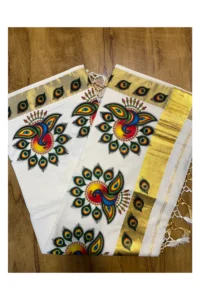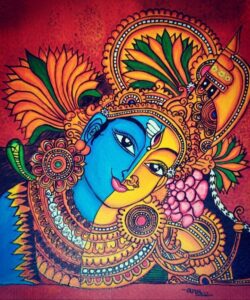
Kerala mural paintings are deeply spiritual and often center around depictions of Hindu gods and goddesses. These artworks bring to life divine forms with vibrant colors, expressive faces, and symbolic gestures (mudras). Deities like Lord Krishna, Shiva, Vishnu, Ganesha, Durga, and Saraswati are the most commonly portrayed.

In Kerala, murals are a traditional art form that adorns the walls of temples and palaces, illustrating scenes from Hindu mythology. While specific murals titled “Ayodhya Wapasi” may not be widely documented, the theme of Lord Rama’s return is a common subject in Kerala murals, especially in temples dedicated to him.
These murals typically portray Lord Rama, accompanied by his wife Sita, brother Lakshmana, and the vanara (monkey) army, entering the city of Ayodhya. The scenes capture the joyous reception by the citizens of Ayodhya, the lighting of lamps (Deepavali), and the coronation of Lord Rama as king.
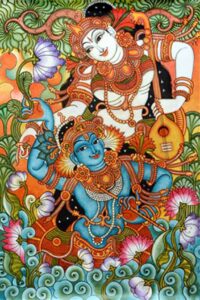
Kerala murals are known for their vivid colors, intricate details, and symbolic use of space. The artists employ natural pigments derived from minerals and plants, and the paintings are characterized by flowing lines and graceful forms. The murals are often created using traditional techniques passed down through generations.Kerala murals are known for their vivid colors, intricate details, and symbolic use of space. The artists employ natural pigments derived from minerals and plants, and the paintings are characterized by flowing lines and graceful forms. The murals are often created using traditional techniques passed down through generations.
Materials Used:
Kerala mural paintings use only natural and eco-friendly materials:
Surface: Lime plastered walls, canvas, or treated wood panels.
Colors (natural pigments):
-
-
Red – from red laterite or red earth
-
Yellow – from yellow clay or turmeric
-
Green – from indigo mixed with turmeric
-
Black – from soot or charcoal
-
White – from limeBinders: Extracts from tender coconut water, neem, or other plant-based materials
-
🖌 Method (Step-by-Step):
-
Surface Preparation: The wall is plastered with lime and allowed to cure.
-
Sketching: The design is outlined using charcoal or a red pigment.
-
Line Work: Intricate lines are drawn with precision to define the forms.
-
Color Filling: Natural pigments are filled in layer by layer, following a strict color scheme.
-
Shading and Detailing: Final touches are added to give depth, emotion, and clarity.
-
Finishing: Sometimes, a protective natural polish is applied.
-
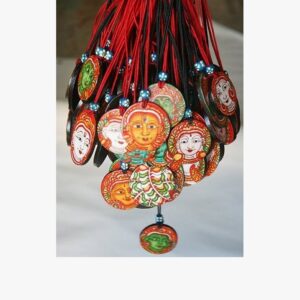
Indian art on jewellery. 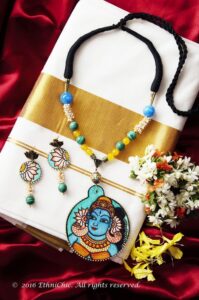
ART OF JEWELLARY
🖌️ Types of Jewelry Depicted in Kerala Murals:
-
Makarakundala – Large ear ornaments shaped like the mythical makara (a sea creature).
-
Kaasu Mala – A long chain made of gold coins, often seen on deities like Lakshmi.
-
Ottakkoru Mala – A single-threaded necklace with a central pendant.
-
Aranjanam – Waist chains, especially shown on child forms of deities like Krishna.
-
Thoda – Traditional ear studs seen on both male and female figures.
-
Nagabharanam – Serpent-like armlets often worn by Lord Shiva.
-
Kankana – Wristlets or bangles depicted in multiple layers on the arms.
🎨 Artistic Style:
-
Highly detailed line work: Artists spend hours detailing the shine, curve, and weight of each ornament.
-
Gold color: A mixture of yellow clay and natural gum gives jewelry a rich, golden hue.
-
Symmetry: Jewelry is painted with perfect symmetry to reflect balance and divinity.
🏛️ Where to See Kerala Mural Jewelry Art:
-
Mattancherry Palace (Dutch Palace), Kochi – Features deities adorned with heavy temple jewelry.
-
Krishna Temple Murals – Often show young Krishna with anklets, necklaces, and pearl adornments.
-
Mural Art Museum, Thrissur – Preserves detailed mural panels including jewelry-rich artworks.
-
Kerala Murals – The Art of Divine Adornment
In Kerala mural paintings, jewelry isn’t just decorative—it’s symbolic. Every ornament worn by gods, goddesses, and celestial beings is painted with great detail and meaning.
✨ Significance:
Jewelry in Kerala murals is not just about wealth—it’s a representation of divine beauty, spiritual power, and cultural identity. Artists ensure that each ornament adds to the character and presence of the deity being painted.
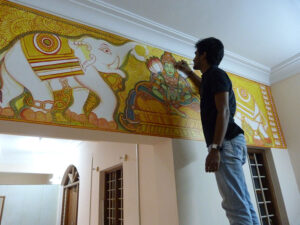
“Divine Colors of Kerala – Ancient Stories on Walls” 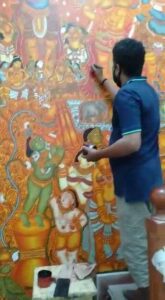
🖼️ Kerala Mural on Wall – Description
Kerala mural paintings on walls are large-scale artworks that adorn the interiors of temples, palaces, and ancient buildings in Kerala. These murals are hand-painted directly onto lime-plastered walls, using natural colors and traditional techniques passed down through generations.
They usually depict mythological themes, scenes from epics like the Ramayana and Mahabharata, and various Hindu deities such as Krishna, Shiva, Vishnu, and Devi. The murals are not just artistic—they’re spiritual expressions intended to create a sacred space
-
-
-

